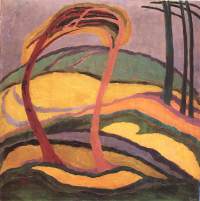
The artistic development of Mattis Teutsch, a painter from Transylvania, was influenced by Gaugain and van Gogh whose works he learnt while in Paris. In the 1910s, his art followed the same path as that of Kandinsky who he met in Munich, but Mattis Teutsch always preserved his individual character. From the cult of lines as a starting point, he arrived at expressivity combining the rhythmic pulsation of organic forms with intensity of colours. The strength of horizontal flow and vertical sway recalls the careful balance of counterpoints in music, and the intensive contrasts of glowing colours are almost of a musical effect. Inner harmonies, however, cannot be burst into pieces by the tensest dynamics either: a cosmic omnipotent principle controls a painful or ecstatic wriggle.
Between 1910 and 1920, Mattis Teutsch experimented with colours, forms and rhythms in series of oil pictures and water colours with ornamental effects, but the original motif of nature, the source of inspiration, retained its character, thus it can always be recognised. In Flowers of Soul (around 1920), a series, elements of vision were transformed into abstract signals: in the correlation of inner and outer worlds, stress was shifted to subjective abstract messages as was the case in the art of Franz Marc. Pure visuality has priority in an art without objects where it is absurd to classify pictures according to subject matter.